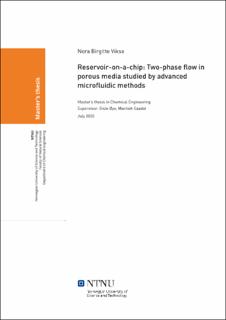| dc.description.abstract | Råolje er den viktigste energikilden i verden. Med en økende etterspørsel etter energi har det blitt viktig å forbedre oljeutvinningen. Flere metoder brukes for å produsere råolje. Imidlertid forblir en stor mengde råolje fanget i porene. En etablert teknikk for å forbedre oljeutvinningen er surfaktant flømming, der målet er å redusere kapillærkreftene, som er hovedårsaken til fanget olje. Vann med lavt saltinnhold har nylig vist seg å forbedre oljeutvinningen ved å endre fuktegenskapene i overflaten til vannfuktighet. Dessuten har tapet av surfaktant vist å avta under forhold med lavt saltinnhold. Dermed har en kombinasjon av lav salinitet vann flømming og surfaktant flømming vist potensial til å forbedre utvinningen av olje.
Denne masteroppgaven tok sikte på å undersøke hvordan en varierende mengde kalsiumioner påvirker fortrengningen av råoljer med løsninger med lavt saltinnhold, med og uten surfaktant, med konstant ionestyrke. Det molare kalsium/natrium forholdet varierte fra 0 til 0.040, og surfaktanten som ble brukt var AOT. Dessuten, studerte bruken av to råoljer effekten av oljesammensetning. Grenseflatespenningen mellom råoljene og løsningene med lavt saltinnhold, med og uten AOT, ble målt for å finne det molare kalsium/natrium forholdet som ga minimum grenseflatespenning. Ett-trinns og to-trinns fortrengningsforsøk ble utført under både hydrofile og hydrofobe forhold. To konstante injeksjonshastigheter ble brukt for å variere kapillærnumrene. Kapillærnumrene i disse eksperimentene varierte fra 1.4E-7 til 6.2E-4.
Målingene av grenseflatespenningene viste en minimum grenseflatespenning mellom råoljene og lav salinitet vann løsningene med surfaktant med det molare kalsium/natrium forholdet lik 0.017. Derfor forventes dette forholdet til å være det optimale punktet for oljeutvinning. Utvinningstrendene oppnådd med en økende mengde kalsium i ett-trinns forskyvningsforsøk så derimot ikke ut til å stemme overens med grenseflatespenning målingene. Når lav salinitet vann løsningene med surfaktant med det molare kalsium/natrium forholdet lik 0 og 0.017 ble injisert på EOR-trinnet, økte utvinningen av olje A med henholdsvis 5 og 6%. For olje C økte utvinningen med omtrent 1 og 4% etter injeksjonen av lav salinitet vann løsningene med surfaktant med det molare kalsium/natrium forholdet på henholdsvis 0 og 0.017. Derfor førte tilstedeværelsen av kalsium til en økning i oljeutvinning. Imidlertid må ytterligere undersøkelser utføres for å vite om dette er det optimale forholdet for oljeutvinning. | |
| dc.description.abstract | Crude oil is the most crucial source of energy in the world. With an increasing demand for energy, it has become essential to enhance oil recovery. Several methods are applied to produce crude oil. However, a large amount of crude oil remains trapped in the pores. An established technique to enhance the oil recovery is surfactant flooding, where the aim is to reduce the capillary forces, which are the main reason for trapped oil. Recently, low salinity water (LSW) flooding has shown to improve the oil recovery by altering surface wettability towards water wetness. Besides, the loss of surfactant has shown to decrease under low salinity conditions. Thus, a combination of low salinity water flooding and surfactant flooding, also called low salinity surfactant (LSS) flooding, has demonstrated the potential to enhance oil recovery.
This master's thesis aimed to investigate how a varying amount of calcium ions affect the displacement of crude oils by low salinity solutions, with and without surfactant, with constant ionic strength. The molar calcium/sodium ranged from 0 to 0.040, and the surfactant used was AOT. Besides, the use of two crude oils studied the effect of oil composition. The interfacial tension between the crude oils and low salinity solutions, with and without AOT, was measured to find the molar calcium/sodium ratio giving minimum IFT. One-step and two-step displacement experiments were performed under both hydrophilic and hydrophobic conditions. Two constant injection rates were used to vary the capillary numbers. The capillary numbers in these experiments ranged from 1.4E-7 to 6.2E-4.
The IFT measurements showed a minimum IFT between the crude oils and the LS-AOT solutions with the molar calcium/sodium ratio equal to 0.017. Hence, the ratio expected as the optimum point for oil recovery. However, the recovery trends obtained with an increasing amount of calcium in the one-step displacement experiments did not seem to be consistent with the IFT results. When the LS-AOT solutions with molar calcium/sodium ratio equal to 0 and 0.017 were flooded at the EOR stage, the recovery of oil A increased by approximately 5 and 6%, respectively. For oil C, the recovery increased by approximately 1 and 4% after injection of the LS-AOT solutions with molar calcium/sodium ratio equal to 0 and 0.017, respectively. Hence, the presence of calcium led to an increase in oil recovery. However, further investigations need to be performed to know if this is the optimal ratio for oil recovery. | |
